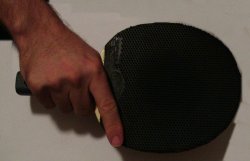
As you can see from the photographs, this grip is similar to the shakehand shallow grip, but the hand is placed further up the handle towards the head of the racket. The index finger is extended along the bottom of the racket, with the thumb now being relaxed on the rubber. The bottom three fingers are used to grip the handle. The basic grip is achieved by ‘shaking hands’ with the racket, hence the name.
Advantages
The advantages of the deep grip is that it prevents the racket from moving in the hand as much, and removes some of the wrist flexibility. This can be useful for strokes requiring precise control and less power.
It is also easy to perform most forehand and backhand strokes with this grip, making it well suited to players who wish to chop from both sides of their body.

Disadvantages
A disadvantage of this grip is that any player using this grip has what is often called a ‘crossover point‘, or an ‘area of indecision’, where the ball cannot easily be struck with either the forehand or backhand side, and a decision to use one or the other stroke must be made.
It can also be difficult to attack balls over the table, due to the lack of wrist movement.
What Type of Player Uses This Grip?
This grip tends to be used by backspin style players, since the defensive strokes used by these players require precise racket control but do not need as much power from the wrist. Defensive players are also less likely to need to attack balls from over the table, so the lesser wrist flexibility is not so important.

